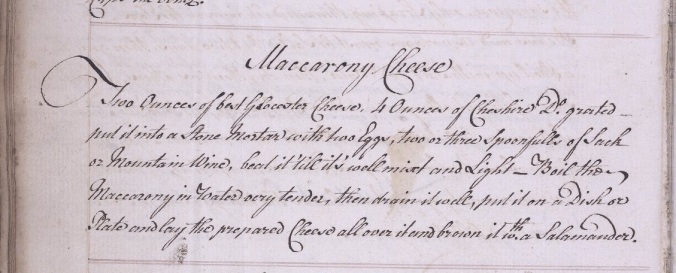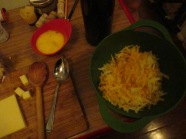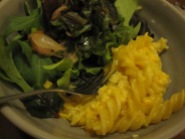
Photo by Carley Storm Photography http://www.carleystormphotography.com
For our inaugural recipe, we thought, why not start with an eighteenth-century mac-and-cheese? It’s a modern-day American classic and perhaps the ultimate comfort food.
This recipe comes from UPenn Ms. Codex 1038, a collection of recipes most likely written and bound between 1765 and 1830. (Thanks to Mitch Fraas for pointing us to this particular “maccarony cheese.”)
The Recipe
Maccarony Cheese
Two Ounces of best Glocester Cheese, 4 Ounces Cheshire Do. grated – put it into a Stone Mortar with two Eggs, two or three Spoonfulls of Sack or Mountain Wine, beat it ’till it’s well mixt and Light – Boil the Maccarony in Water very tender, then drain it well, put it on a Dish or Plate and lay the prepared Cheese all over it and brown it with a Salamander.
This recipe, unlike some others to be featured, discussed, and puzzled over here in the next few months, features no ingredients that are mysterious, challenging to obtain, or downright unappetizing. Cheese, eggs, and macaroni are all familiar. Even sack wine can be approximated. Defined in Samuel Johnson’s 1737 Dictionary as “A kind of sweet wine, now brought chiefly from the Canaries.” Also known as “Canary wine,” sack identified a few varieties of sweet, fortified light wine. One of these later became known as “sherry,” so sherry is what we turned to here. For Gloucester cheese, we substituted a sharp, aged cheddar; for Cheshire, a milder cheddar.
Note that although the recipe provides specific measurements for all ingredients of the cheese sauce, the amount of macaroni is left unspecified. Based on the amount of cheese sauce, we determined that approximately half a pound of pasta (ex. fusili) would most likely have been used.
Early modern cooks used salamanders to brown dishes. A salamander was a piece of cast iron with a handle attached; it would be heated in the fire and then held on top of a dish to warm it. Essentially, a salamander was a hand-held broiler. We debated using a culinary torch but decided that an oven would provide more even cooking.
So, our modern version of the recipe looked like this:
2 oz. sharp/dry cheddar
4 oz. mild cheddar
2 eggs
2 tsp. sherry
8 oz. dried pasta
Heat oven to 350F.
Grate the cheeses and beat together with eggs and sherry. Add salt and pepper to taste. Cook and drain pasta.
Transfer pasta to oven-proof dish and evenly distribute cheese sauce over the top. Bake for 15-20 minutes, until cheese is melted and lightly browned.
The Results
In a word: delicious. The eggs cooked with the cheese to form a dense, satisfying mac-and-cheese that was remarkably easy to make. And the sherry flavor came through in a unique, rich way. We both agreed that this would be an easy way to throw together a pasta dish for one or two people, using up any scraps of cheese. Even more impressive: unlike many modern recipes for mac-and-cheese, this one does not involve any milk or heavy cream.





You must be logged in to post a comment.